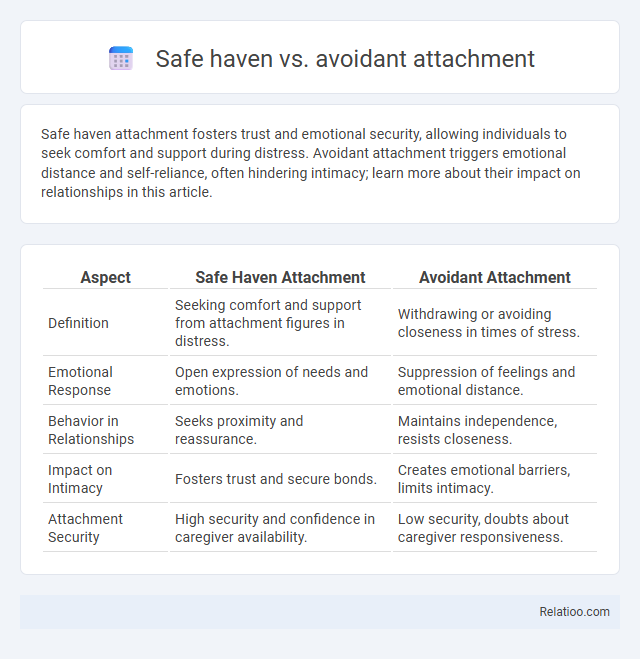Safe haven attachment fosters trust and emotional security, allowing individuals to seek comfort and support during distress. Avoidant attachment triggers emotional distance and self-reliance, often hindering intimacy; learn more about their impact on relationships in this article.
Table of Comparison
| Aspect | Safe Haven Attachment | Avoidant Attachment |
|---|---|---|
| Definition | Seeking comfort and support from attachment figures in distress. | Withdrawing or avoiding closeness in times of stress. |
| Emotional Response | Open expression of needs and emotions. | Suppression of feelings and emotional distance. |
| Behavior in Relationships | Seeks proximity and reassurance. | Maintains independence, resists closeness. |
| Impact on Intimacy | Fosters trust and secure bonds. | Creates emotional barriers, limits intimacy. |
| Attachment Security | High security and confidence in caregiver availability. | Low security, doubts about caregiver responsiveness. |
Understanding Attachment Theory: Key Concepts
Safe haven refers to the emotional security a person seeks from a trusted individual during times of distress, providing comfort and reassurance. Avoidant attachment describes a pattern where an individual suppresses the desire for closeness, often distancing themselves from others to maintain independence. Understanding these key concepts helps you recognize how attachment styles influence relationship dynamics and emotional regulation.
Defining Safe Haven in Attachment Styles
Safe haven in attachment styles refers to the comforting and secure presence an individual seeks during times of distress or threat, fostering emotional regulation and reassurance. Unlike avoidant attachment, where individuals suppress emotional needs and maintain distance from close connections, a safe haven promotes open emotional expression and dependable support. Your ability to recognize and cultivate a safe haven in relationships enhances emotional resilience and attachment security.
What is Avoidant Attachment?
Avoidant attachment is a type of insecure attachment style characterized by emotional distance and discomfort with closeness in relationships. Individuals with avoidant attachment often suppress their feelings and prioritize independence to protect themselves from potential rejection or vulnerability. Unlike the safe haven attachment, which provides comfort and security during stress, avoidant attachment results in avoidance of intimacy and difficulty relying on others for support.
Emotional Availability: Safe Haven vs Avoidant Attachment
Emotional availability significantly differs between safe haven and avoidant attachment, impacting how Your needs for comfort and support are met during distress. Safe haven attachment ensures responsive and accessible emotional support, fostering trust and security in relationships. In contrast, avoidant attachment is characterized by emotional distance and reluctance to provide comfort, leading to feelings of isolation and unmet emotional needs.
Childhood Influences on Attachment Formation
Childhood influences on attachment formation shape the development of safe haven behaviors, where children seek comfort and security from caregivers during distress. Avoidant attachment arises when caregivers consistently reject or ignore children's bids for closeness, leading to emotional distance and self-reliance. Safe haven attachment results from sensitive, responsive caregiving that fosters trust and emotional regulation in the child.
Relationship Dynamics: Seeking Comfort or Distancing
Safe haven attachment involves seeking comfort and support from a partner during times of distress, fostering secure emotional bonds and trust. Avoidant attachment, in contrast, leads individuals to distance themselves and suppress emotional needs to maintain independence and avoid vulnerability. These differing relationship dynamics impact how partners navigate conflict and intimacy, influencing overall relationship satisfaction and stability.
Signs of a Safe Haven Attachment Relationship
Signs of a safe haven attachment relationship include consistent emotional support, reliable comfort during stress, and a secure base for exploring the world. Unlike avoidant attachment, individuals with a safe haven attachment openly seek closeness and trust their partner in times of distress. Behavioral cues such as effective communication, mutual responsiveness, and emotional regulation characterize this secure attachment style.
Common Behaviors in Avoidant Attachment Patterns
Avoidant attachment is characterized by a reluctance to seek comfort from others, often displaying emotional distance and self-reliance when stressed. Common behaviors include suppressing feelings, avoiding closeness, and downplaying the importance of relationships, which contrasts sharply with safe haven dynamics where individuals seek and provide comfort and security. Unlike safe haven figures who offer consistent support, avoidantly attached individuals often dismiss or withdraw from emotional intimacy to maintain independence.
Impacts on Adult Relationships and Emotional Well-being
Safe haven attachment fosters secure emotional bonds, promoting trust and effective communication in adult relationships, which significantly enhances emotional well-being and resilience. Avoidant attachment often leads to emotional distancing, difficulty in intimacy, and heightened stress levels, negatively impacting relationship satisfaction and mental health. Understanding these attachment dynamics is critical for developing healthier interpersonal connections and improving overall emotional stability.
Healing and Shifting Attachment Styles
Healing and shifting attachment styles involve recognizing the distinct roles of safe haven and avoidant attachment patterns in your emotional experiences. Safe haven attachments provide comfort and security during distress, fostering emotional regulation and trust, while avoidant attachment often leads to distancing behaviors that inhibit vulnerability and connection. Therapeutic interventions and mindful self-awareness can facilitate the transition from avoidant tendencies to secure safe haven attachment, promoting healthier relationships and emotional resilience.

Infographic: Safe haven vs Avoidant attachment
 relatioo.com
relatioo.com